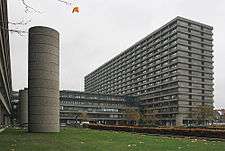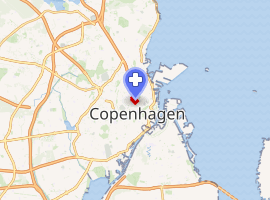Rigshospitalet
Rigshospitalet (meaning The National, State or Kingdom Hospital, but not usually translated) is one of the largest hospitals in Denmark and the most highly specialised hospital in Copenhagen. The hospital's main building is a 16 storey functionalist highrise, one of the tallest structures in the central parts of the city. Rigshospitalet neighbours the Panum Building which houses the Faculty of Health and Medical Sciences at the University of Copenhagen. As a teaching hospital it is part of the framework organisation Copenhagen University Hospital.[2]
| Rigshospitalet | |
|---|---|
| Capital Region of Denmark | |
 | |
 | |

| |
| Geography | |
| Location | Copenhagen, Capital Region, Denmark |
| Coordinates | 55°41′48″N 12°34′00″E |
| Organisation | |
| Funding | Government hospital |
| Type | Teaching |
| Affiliated university | University of Copenhagen |
| Services | |
| Emergency department | Yes |
| Beds | 1,118[1] |
| Helipad | Yes |
| History | |
| Opened | 30 March 1757 |
| Links | |
| Website | www.rigshospitalet.dk |
Name
The Danish name is not usually translated to English.[3] The prefix Rigs- is used in the names of some Danish state institutions, especially in a solemn or prestigious context or for authorities serving for the whole Danish Realm including Greenland and the Faroe Islands. It is the genitive of rige ('realm, kingdom, empire') and the cognate word is used similarly in Norwegian, Swedish, Icelandic and Dutch (and in German until 1945). The prefix Stats- ('of the state') is more widely used, but implies a slightly lower level in the hierarchy. Although Rigshospitalet was founded as a state hospital, as opposed to the normal hospitals operated by counties, the Danish term Statshospital was until 1977 used only for psychiatric institutions.
The hospital itself explains the name was given because its predecessor, Royal Frederick's Hospital, was handed over to the state and became open to patients from the whole Danish Realm.[4]
Rigshospitalet is often abbreviated RH and colloquially also called Riget (literally meaning 'the realm' or 'the kingdom'), hence the name of Lars von Trier's thriller TV series The Kingdom which was set at the hospital, and Stephen King's American version Kingdom Hospital.
History
Rigshospitalet was founded on 30 March 1757 as Kongelig Frederiks Hospital, named after King Frederick V and situated in Bredgade in central Copenhagen. The buildings are now occupied by the Danish Museum of Art & Design. Since 1903 the state has been the owner of the hospital (whereas other hospitals in Denmark are owned by the regions, formerly by the counties). In 1910 the hospital was renamed and moved to its present location in ten low buildings surrounding a central garden designed by architect Martin Borch. In 1970 most of the buildings were replaced by the present highrise concrete building designed by architect Jørgen Stærmose, while some of the surrounding older buildings still serve hospital functions. In 1995 the hospital was handed over to Hovedstadens Sygehusfællesskab (HS, The Capital Hospital Trust) which in 2007 was absorbed by the Capital Region. In 2007 a helipad was built on top of the hospital. Until then, rescue helicopters and helicopters transferring patients would land in the neighbouring park Fælledparken.
Hospital services
Rigshospitalet's mission is to be Denmark's leading hospital for patients needing highly specialized treatment.[5] Its main specialist role has been enhanced in recent years by the decision that it should serve as the host institution for many of Copenhagen's speciality departments. Because of this, other hospitals refer patients to Rigshospitalet for the unique expertise available there.
Rigshospitalet's neighbor, the Panum Building, houses the University of Copenhagen's Faculty of Health and Medical Sciences. This proximity optimizes a close cooperation between the two in the fields of research and development. The Nordic Cochrane Centre and the University Centre for Nursing and Care Research are in Rigshospitalet.
With 1,120 beds, Rigshospitalet has responsibility for 65,000 inpatients and approximately 420,000 outpatients annually. In addition to its 8,000 personnel (7,000 full-time equivalents), the hospital trains, hosts, and has the in-service advantages of students of medicine and other health care sciences, as well as scientists working within Rigshospitalet under a variety of research grants.
Rigshospitalet has a trauma centre specialised at receiving severely injured patients. Ordinary emergency department treatment has been relegated to the other hospitals in Copenhagen.
Social and cultural significance
The hospital was the location of Lars von Trier's television horror mini-series The Kingdom.
It's the preferred hospital when members of the Danish royal family give birth.
Queen Margrethe and Prince Henrik's children, Crown Prince Frederik and Prince Joachim, were both born at Rigshospitalet. Likewise Crown Princess Mary gave birth to her four children by Crown Prince Frederik: Christian, Isabella, Vincent, and Josephine, and all of Prince Joachim's four children were born here: Nikolai, Felix, Henrik and Athena.
In 2007 Rigshospitalet celebrated its 250th anniversary.
Blood contamination
Two patients were infected with HIV at Rigshospitalet in February 2007 after getting a blood transfusion with infected blood. The contagion could, according to experts, probably have been discovered if the blood had been tested with a NAT test, which since 2009 is a requirement.[6][7]
Psychiatry
Though the hospital complex also houses the Psychiatric Centre Rigshospitalet, this centre is administratively under the region-wide psychiatric hospital, Region Hovedstadens Psykiatri.
Additional images
.jpg) Main entrance
Main entrance.jpg) EH101 helicopter takeoff from helipad
EH101 helicopter takeoff from helipad Rigshospitalet in 1910
Rigshospitalet in 1910
References
- Rigshospitalet. "Key Numbers". rigshospitalet.dk (in Danish). Retrieved 3 November 2017.
- [universitetshospital.ku.dk Københavns Universitetshospital], University of Copenhagen
- Rigshospitalet - in brief, Rigshospitalet
- The History of Rigshospitalet, Rigshospitalet
- "Archived copy" (PDF). Archived from the original (PDF) on 2005-12-24. Retrieved 2006-06-03.CS1 maint: archived copy as title (link)
- "To smittet med hiv på Rigshospitalet - Politiken.dk". 070818 politiken.dk
- "Læger vil gøre donorblod mere sikkert - Indland - Nyheder - Berlingske Tidende". 070818 berlingske.dk
External links
| Wikimedia Commons has media related to Rigshospitalet. |